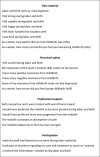Dosage of oxytocin for augmentation of labor and women's childbirth experiences: A randomized controlled trial
- PMID: 33176392
- PMCID: PMC8248083
- DOI: 10.1111/aogs.14042
Dosage of oxytocin for augmentation of labor and women's childbirth experiences: A randomized controlled trial
Abstract
Introduction: The aim of this study was to compare childbirth experiences and experience of labor pain in primiparous women who had received high- vs low-dose oxytocin for augmentation of delayed labor.
Material and methods: A multicenter, parallel, double-blind randomized controlled trial took place in six Swedish labor wards. Inclusion criteria were healthy primiparous women at term with uncomplicated singleton pregnancies, cephalic fetal presentation, spontaneous onset of labor, confirmed delayed labor progress and ruptured membranes. The randomized controlled trial compared high- vs low-dose oxytocin used for augmentation of a delayed labor progress. The Childbirth Experience Questionnaire version 2 (CEQ2) was sent to the women 1 month after birth. The CEQ2 consists of 22 items in four domains: Own capacity, Perceived safety, Professional support and Participation. In addition, labor pain was reported with a visual analog scale (VAS) 2 hours postpartum and 1 month after birth. The main outcome was the childbirth experience measured with the four domains of the CEQ2. The clinical trial number is NCT01587625.
Results: The CEQ2 was sent to 1203 women, and a total of 1008 women (83.8%) answered the questionnaire. The four domains of childbirth experience were scored similarly in the high- and low-dose oxytocin groups of women: Own capacity (P = .36), Perceived safety (P = .44), Professional support (P = .84), Participation (P = .49). VAS scores of labor pain were reported as similar in both oxytocin dosage groups. Labor pain was scored higher 1 month after birth compared with 2 hours postpartum. There was an association between childbirth experiences and mode of birth in both the high- and low-dose oxytocin groups.
Conclusions: Different dosage of oxytocin for augmentation of delayed labor did not affect women's childbirth experiences assessed through CEQ2 1 month after birth, or pain assessment 2 hours or 1 month after birth.
Keywords: birth; childbirth experience; delayed labor; labor pain; oxytocin augmentation; randomized controlled trial.
© 2020 The Authors. Acta Obstetricia et Gynecologica Scandinavica published by John Wiley & Sons Ltd on behalf of Nordic Federation of Societies of Obstetrics and Gynecology (NFOG).
Conflict of interest statement
None.
Figures
Similar articles
-
Women's experiences after early versus postponed oxytocin treatment of slow progress in first childbirth--a randomized controlled trial.Sex Reprod Healthc. 2012 Jun;3(2):61-5. doi: 10.1016/j.srhc.2012.03.003. Epub 2012 Mar 24. Sex Reprod Healthc. 2012. PMID: 22578752 Clinical Trial.
-
Women's childbirth experiences in the Swedish Post-term Induction Study (SWEPIS): a multicentre, randomised, controlled trial.BMJ Open. 2021 Apr 7;11(4):e042340. doi: 10.1136/bmjopen-2020-042340. BMJ Open. 2021. PMID: 33827832 Free PMC article. Clinical Trial.
-
Overall childbirth experience: what does it mean? A comparison between an overall childbirth experience rating and the Childbirth Experience Questionnaire 2.BMC Pregnancy Childbirth. 2023 Mar 14;23(1):176. doi: 10.1186/s12884-023-05498-5. BMC Pregnancy Childbirth. 2023. PMID: 36918812 Free PMC article.
-
Birth as a neuro-psycho-social event: An integrative model of maternal experiences and their relation to neurohormonal events during childbirth.PLoS One. 2020 Jul 28;15(7):e0230992. doi: 10.1371/journal.pone.0230992. eCollection 2020. PLoS One. 2020. PMID: 32722725 Free PMC article. Review.
-
Role of Prophylactic Oxytocin in the Third Stage of Labor: Physiologic Versus Pharmacologically Influenced Labor and Birth.J Midwifery Womens Health. 2017 Jul;62(4):418-424. doi: 10.1111/jmwh.12620. Epub 2017 Jul 13. J Midwifery Womens Health. 2017. PMID: 28703925 Review.
Cited by
-
Oxytocin in Women's Health and Disease.Front Endocrinol (Lausanne). 2022 Feb 15;13:786271. doi: 10.3389/fendo.2022.786271. eCollection 2022. Front Endocrinol (Lausanne). 2022. PMID: 35242106 Free PMC article. Review.
-
Impact of collegial midwifery assistance during second stage of labour on women's experience: a follow-up from the Swedish Oneplus randomised controlled trial.BMJ Open. 2024 Jul 27;14(7):e077458. doi: 10.1136/bmjopen-2023-077458. BMJ Open. 2024. PMID: 39067883 Free PMC article. Clinical Trial.
-
Maternal childbirth experience and pain relief methods: a retrospective 7-year cohort study of 85 488 parturients in Finland.BMJ Open. 2022 May 9;12(5):e061186. doi: 10.1136/bmjopen-2022-061186. BMJ Open. 2022. PMID: 35534068 Free PMC article.
-
Spontaneous Perineal Trauma during Non-Operative Childbirth-Retrospective Analysis of Perineal Laceration Risk Factors.Int J Environ Res Public Health. 2022 Jun 23;19(13):7653. doi: 10.3390/ijerph19137653. Int J Environ Res Public Health. 2022. PMID: 35805312 Free PMC article.
References
-
- Lundgren I. Swedish women’s experience of childbirth 2 years after birth. Midwifery. 2005;21:346‐354. - PubMed
-
- Waldenstrom U, Hildingsson I, Rubertsson C, Radestad I. A negative birth experience: prevalence and risk factors in a national sample. Birth. 2004;31:17‐27. - PubMed
-
- Ayers S, Bond R, Bertullies S, Wijma K. The aetiology of post‐traumatic stress following childbirth: a meta‐analysis and theoretical framework. Psychol Med. 2016;46:1121‐1134. - PubMed
-
- Dencker A, Nilsson C, Begley C, et al. Causes and outcomes in studies of fear of childbirth: a systematic review. Women Birth. 2019;32:99‐111. - PubMed
-
- Shorey S, Yang YY, Ang E. The impact of negative childbirth experience on future reproductive decisions: a quantitative systematic review. J Adv Nurs. 2018;74:1236‐1244. - PubMed
Publication types
MeSH terms
Substances
Associated data
LinkOut - more resources
Full Text Sources
Other Literature Sources
Medical



